다모증과 성인 남성형 다모증, Hypertrichosis and Hirsutism
다모증과 성인 남성형 다모증의 개요와 원인
- 의학적으로 경모가 성인에게 남성 형으로 과다하게 나타 날 때 다모증(Hirsutism)이라고 한다.
- 성인의 신체에 나는 단단하고 굵은 털을 경모라고 한다.
- 경모가 정상으로 나는지 과다하게 많이 나는지 정상 이하로 적게 나는지는 퍼리만 갤웨이 스케일(Ferriman-Gallwey scale)로 결정한다, 출처-The New England Journal of Medicine, 12, 2005.
- 털이 국소적으로나 전신적으로, 선천성으로 후천성으로, 정상적으로, 비정상적으로 많이 나는 증상 징후를 통틀어 다모증이라고 한다.
- 여성들이나 소아청소년들의 털이 성인 남성들의 털이 나는 양식으로 과다히 나는 것을 성인 남성형 다모증이라 한다.
- 성인 남성들에게 나는 털 양식으로 나지 않고 국소적으로, 또는 전신적으로 비정상적으로 털이 많이 날 때 그냥 다모증이라고 한다.
- 남성형 다모증의 대부분의 원인은 생리적이고 아주 드물게는 내분비선 이상이다.
다모증과 성인 남성형 다모증의 종류
- 다모증을 선천성 다모증과 후천성 다모증,
- 솜털성 다모증,
- 전신성 다모증,
- 이개 다모증,
- 모반양 다모증 등으로 분류할 수 있고
- 성인 남성형 다모증은 특발성 성인 남성형 다모증과 내분비선 성인 남성형 다모증으로 분류할 수 있다.
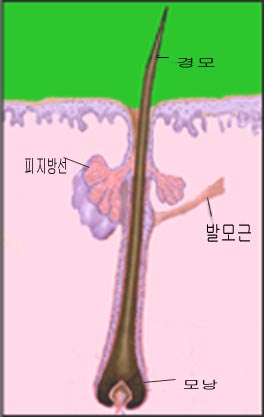
그림 541. 경모.
Copyrightⓒ 2012 John Sangwon Lee, MD., FAAP
1. 솜털성 다모증 Lanugo and vellus
- 솜털성 다모증은 배냇 솜털(Lanugo)로 갓 태어난 신생아들에게 주로 난다.
- 또는 신생아에게 연모(Vellus) 과다로 난다.
- 일시적으로 생기고 자연적으로 치료되는 것이 보통이나 드물게는 유전성으로 솜털성 다모증이 생겨 솜털이 전신에 정상 이상으로 더 많이 날 수 있다.
- 태아 배냇 솜털은 임신 38주까지 대개 빠지는 것이 보통이다.
- 미숙아에게는 선천성 배냇 솜털 다모증이 더 잘 생긴다.
- 태어날 때부터 있던 솜털성 다모증은 생후 1~6개월까지 자연적으로 없어지면서 그 솜털이 정상 경모 체모로 바꾸어 나는 것이 보통이다.
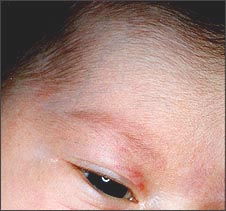
사진542. 이마에 난 솜털성 다모증과 위 눈 꺼플에 난 연어색 반점.
갓 태어난 신생아들이나 영유아들에게서 솜털성 다모증을 흔히 볼 수 있다. 이 아기의 이마에 솜털이 많이 나 있다.
Copyrightⓒ 2012 John Sangwon Lee, MD., FAAP
2. 모반양 다모증 Hypertrichosis in Pigmented nevi
- 피부의 일부에 모반이 국소적으로 생기고 그 모반에 털이 많이 나는 것을 모반양 다모증이라 한다.
- 때로는 모반은 없는데 털만 국소적으로 많이 나 있는 경우도 있다.
- 원인과 정도에 따라 치료한다.
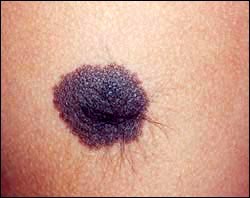
사진 543. 색소성 모반에 난 모반양 다모증.
Copyrightⓒ 2012 John Sangwon Lee, MD., FAAP
3. 전신성 다모증 Systemic hypertrichosis
- 뇌염을 앓은 후, 다발성 경화증, 신경성 식욕부전 등 정신 신경성 질환이나 부갑상선 기능 항진증, 피부 근염, 심한 영양부족, 약물 복용, 코르티코스테로이드제 치료 등으로 전신성 다모증이 생길 수 있다.
- 어떤 원인이 없이 선천성으로 전신성 다모증이 생길 수 있고
- 또 아토피 체질이 있는 소아청소년들이나 성인들에게 전신성 다모증이 더 잘 생긴다.
- 치료는 원인과 정도에 따라 한다.
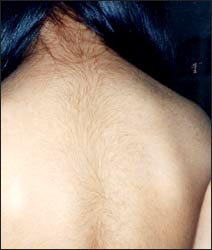
사진 544. 사춘기 여아에게 생긴 전신성 다모증.
Copyrightⓒ 2012 John Sangwon Lee, MD., FAAP
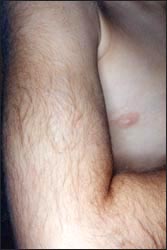
사진 545. 사춘기 남아에게 생긴 전신성 다모증.
Copyrightⓒ 2012 John Sangwon ee, MD., FAAP
4. 특발성 성인 남성형 다모증 Idiopathic male pattern hirsutism
- 내분비선 이상이나 신진대사 이상, 또는 아무런 원인이 없이 여성이나 소아청소년의 털이 성인 남성형 털 양식으로 많이 난 것을 특발성 성인 남성형 다모증이라고 한다.
- 특발성 성인 남성형 다모증이 있으면 털이 여성들이나 소아들의 얼굴, 상체, 가슴, 배, 팔과 다리 등에 성인 남성형 털 양식처럼 나는 것이 보통이다.
- 라틴계 사람들이나 유태계 사람들에게서 이런 특발성 성인 남성형 다모증이 정상적으로 더 흔히 생길 수 있다.
- 치료 : 원인 없이 생긴 특발성 성인 남성형 다모증은 가위로 털을 깎든지 면도로 깎든지 6% 과산화수소 액으로 탈색시키거나 부석으로 문지르거나 털을 뽑거나 전기 분해법 치료, 전기 외과적 제거방법 등으로 털을 뽑아 치료하든지 그냥 관찰치료를 한다.
5. 내분비선 이상으로 인한 성인 남성형 다모증 Male pattern hirsutism due to endocrine disorder
- 뇌하수체, 부신, 또는 난소 등 내분비선 이상으로 인해 남성 호르몬 분비가 증가되고 비정상으로 몸에 털이 많이 날 수 있다.
- 이렇게 내분비선 이상으로 생기는 성인 남성형 털과 같이 나는 다모증을 내분비선 성인 남성형 다모증이라고 한다.
- 이 병이 있을 때는 털만 비정상으로 많이 나지 않고 여성의 음성이 남성의 음성과 같이 변할 수 있고 월경 이상도 생길 수 있고, 비만증, 음핵 비대 등의 증상징후가 동시에에 생기는 것이 보통이다. 이런 종류의 다모증은 아주 드물다.
- 다낭성 난소 증후군이 있으면 내분비선성 성인 남성형 다모증이 생길 수 있다.
- 무월경, 비만증도 생기고 난소에 다수의 낭포가 생긴다.
- 또 배란이 되지 않아서 임신이 되지 않을 수 있다.
- 치료는 원인에 따라 한다.
- [부모도 반의사가 되어야 한다-소아가정간호 백과] – 제 14권 소아청소년 내분비, 유전, 염색체, 대사, 희귀병 질환-다낭성 난소 증후군(Polycystic ovary syndrome)
Hypertrichosis and Hirsutism
Overview and causes of hirsutism and androgenetic hirsutism in adults
• Medically, it is called hirsutism when terminal hairs appear excessively in the male form in adults.
• Hard, thick hair on an adult’s body is called terminal hair.
• Whether terminal hair growth is normal, excessive, or less than normal, is determined by the Ferriman-Gallwey scale, Source-The New England Journal of Medicine, 12, 2005.
• Hirsutism is a group of symptoms and signs that hairs grow locally or systemically, congenitally or acquired, normally and abnormally.
• Excessive growth of hair in women and adolescents in the same manner as adult men are known as androgenetic hirsutism.
• For adult males, when I do not grow baldly, it is just called hirsutism when it is abnormally hairy, either locally or systemically.
• Most causes of androgenetic hirsutism are physiological and, very rarely, endocrine abnormalities.
Types of hirsutism and adult androgenetic hirsutism
• Hirsutism congenital hirsutism, acquired hirsutism,
• hirsutism follicles,
• hirsutism systemic
; • hirsutism of the auricle,
• It can be classified as hirsutism nevi, etc.
• Androgenetic hirsutism can be classified into idiopathic androgenetic hirsutism and endocrine androgenic hirsutism.

Fig. 541. Terminal cap. Copyright© 2012 John Sangwon Lee, MD., FAAP
1. hirsutism lanugo and vellus
• Hirsutism follicles occurs mainly in newborn babies with lanugo.
• Or in newborns, due to an excess of Vellus.
• It is usually temporary and resolves spontaneously, but in rare cases, a hereditary hirsutism may cause an abnormally large amount of downy all over the body.
• Fetal fluff usually falls out by the 38th week of pregnancy.
• Premature infants are more prone to congenital hirsutism.
• Hirsutism follicles from birth disappear naturally by 1 to 6 months of age, and it is common for the downy hair to be replaced with normal terminal hair.

Picture 542. Hirsutism follicles on the forehead and salmon-colored spots on the upper eyelid. Hirsutism follicles are common in newborns and infants. There’s a lot of fluff on this baby’s forehead. Copyright© 2012 John Sangwon Lee, MD., FAAP
2. Hypertrichosis in Pigmented nevi
• Hirsutism nevus is a localized nevi on a part of the skin and a lot of hairs on the nevi. • Sometimes there are no birthmarks, but there are many localized hairs.
• Treatment depends on the cause and severity.

Picture 543. Hirsutism nevus nevus pigmentosa. Copyright© 2012 John Sangwon Lee, MD., FAAP
3. Systemic hypertrichosis
• After encephalitis, systemic hirsutism may occur due to psychoneurotic diseases such as multiple sclerosis and anorexia nervosa, hyperparathyroidism, dermatomyositis, severe malnutrition, drug use, and corticosteroid treatment. • Systemic hirsutism can be congenital without any cause and
• Also, hirsutism systemic is more common in children and adolescents and adults with atopic constitution. • Treatment depends on the cause and severity.

Picture 544. Systemic hirsutism in adolescent girls. Copyright© 2012 John Sangwon Lee, MD., FAAP Picture 545. Systemic hirsutism in adolescent boys. Copyright© 2012 John Sangwon ee, MD., FAAP
4. Idiopathic male pattern hirsutism
• Idiopathic androgenetic hirsutism is a condition in which females and children and adolescents grow a lot of hair in the adult male pattern without any endocrine or metabolic abnormalities or any cause.
• With idiopathic androgenetic hirsutism, it is common for hair to grow on the face, upper body, chest, belly, arms and legs of women and children like adult male pattern hair patterns.
• This type of idiopathic androgenetic hirsutism in adults is normally more common in people of Latino or Jewish descent.
• Treatment: For idiopathic adult male pattern hirsutism that occurs without a cause, the hair is removed with scissors or shaving, bleaching with 6% hydrogen peroxide, rubbing with a pumice stone, pulling out hair, electrolysis treatment, electrosurgical removal, etc. Remove and treat, or simply observe.
5. Male pattern hirsutism due to endocrine disorder
• An abnormality in the endocrine glands, such as the pituitary gland, adrenal gland, or ovary, increases the secretion of male hormones and may cause abnormal hair growth.
• Hirsutism like adult male pattern hair that occurs due to abnormalities in the endocrine glands is called endocrine gland male pattern hirsutism.
• When there is this disease, only the hair is not abnormally large, the female voice can change to the male voice, menstrual abnormalities can occur, and symptoms such as obesity and clitoris enlargement are common at the same time. This type of hirsutism is very rare.
• If you have polycystic ovary syndrome, you may develop endocrine and androgenetic hirsutism. • Amenorrhea, obesity, and many cysts in the ovaries.
• You may not be able to conceive because you are not ovulating. • Treatment depends on the cause.
• www.drleepediatrics.com – Vol. 14 Pediatric Endocrinology, Genetics, Chromosomes, Metabolism, Rare Diseases – Polycystic ovary syndrome
출처 및 참조 문헌 Sources and references
- NelsonTextbook of Pediatrics 22ND Ed
- The Harriet Lane Handbook 22ND Ed
- Growth and development of the children
- Red Book 32nd Ed 2021-2024
- Neonatal Resuscitation, American Academy of Pediatrics
- www.drleepediatrics.com 제1권 소아청소년 응급 의료
- www.drleepediatrics.com 제2권 소아청소년 예방
- www.drleepediatrics.com 제3권 소아청소년 성장 발육 육아
- www.drleepediatrics.com 제4권 모유,모유수유, 이유
- www.drleepediatrics.com 제5권 인공영양, 우유, 이유식, 비타민, 미네랄, 단백질, 탄수화물, 지방
- www.drleepediatrics.com 제6권 신생아 성장 발육 육아 질병
- www.drleepediatrics.com제7권 소아청소년 감염병
- www.drleepediatrics.com제8권 소아청소년 호흡기 질환
- www.drleepediatrics.com제9권 소아청소년 소화기 질환
- www.drleepediatrics.com제10권. 소아청소년 신장 비뇨 생식기 질환
- www.drleepediatrics.com제11권. 소아청소년 심장 혈관계 질환
- www.drleepediatrics.com제12권. 소아청소년 신경 정신 질환, 행동 수면 문제
- www.drleepediatrics.com제13권. 소아청소년 혈액, 림프, 종양 질환
- www.drleepediatrics.com제14권. 소아청소년 내분비, 유전, 염색체, 대사, 희귀병
- www.drleepediatrics.com제15권. 소아청소년 알레르기, 자가 면역질환
- www.drleepediatrics.com제16권. 소아청소년 정형외과 질환
- www.drleepediatrics.com제17권. 소아청소년 피부 질환
- www.drleepediatrics.com제18권. 소아청소년 이비인후(귀 코 인두 후두) 질환
- www.drleepediatrics.com제19권. 소아청소년 안과 (눈)질환
- www.drleepediatrics.com 제20권 소아청소년 이 (치아)질환
- www.drleepediatrics.com 제21권 소아청소년 가정 학교 간호
- www.drleepediatrics.com 제22권 아들 딸 이렇게 사랑해 키우세요
- www.drleepediatrics.com 제23권 사춘기 아이들의 성장 발육 질병
- www.drleepediatrics.com 제24권 소아청소년 성교육
- www.drleepediatrics.com 제25권 임신, 분만, 출산, 신생아 돌보기
- Red book 29th-31st edition 2021
- Nelson Text Book of Pediatrics 19th- 21st Edition
- The Johns Hopkins Hospital, The Harriet Lane Handbook, 22nd edition
- 응급환자관리 정담미디어
- Pediatric Nutritional Handbook American Academy of Pediatrics
- 소아가정간호백과–부모도 반의사가 되어야 한다, 이상원 저
- The pregnancy Bible. By Joan stone, MD. Keith Eddleman, MD
- Neonatology Jeffrey J. Pomerance, C. Joan Richardson
- Preparation for Birth. Beverly Savage and Dianna Smith
- 임신에서 신생아 돌보기까지. 이상원
- Breastfeeding. by Ruth Lawrence and Robert Lawrence
- Sources and references on Growth, Development, Cares, and Diseases of Newborn Infants
- Emergency Medical Service for Children, By Ross Lab. May 1989. p.10
- Emergency care, Harvey Grant and Robert Murray
- Emergency Care Transportation of Sick and Injured American Academy of Orthopaedic Surgeons
- Emergency Pediatrics A Guide to Ambulatory Care, Roger M. Barkin, Peter Rosen
- Quick Reference To Pediatric Emergencies, Delmer J. Pascoe, M.D., Moses Grossman, M.D. with 26 contributors
- Neonatal resuscitation Ameican academy of pediatrics
- Pediatric Nutritional Handbook American Academy of Pediatrics
- Pediatric Resuscitation Pediatric Clinics of North America, Stephen M. Schexnayder, M.D.
-
Pediatric Critical Care, Pediatric Clinics of North America, James P. Orlowski, M.D.
-
Preparation for Birth. Beverly Savage and Dianna Smith
-
Infectious disease of children, Saul Krugman, Samuel L Katz, Ann A.
- 제4권 모유, 모유수유, 이유 참조문헌 및 출처
- 제5권 인공영양, 우유, 이유, 비타민, 단백질, 지방 탄수 화물 참조문헌 및 출처
- 제6권 신생아 성장발육 양호 질병 참조문헌 및 출처
- 소아과학 대한교과서
Copyright ⓒ 2014 John Sangwon Lee, MD., FAAP
“부모도 반의사가 되어야 한다”-내용은 여러분들의 의사로부터 얻은 정보와 진료를 대신할 수 없습니다.
“The information contained in this publication should not be used as a substitute for the medical care and advice of your doctor. There may be variations in treatment that your doctor may recommend based on individual facts and circumstances.
“Parental education is the best medicine.